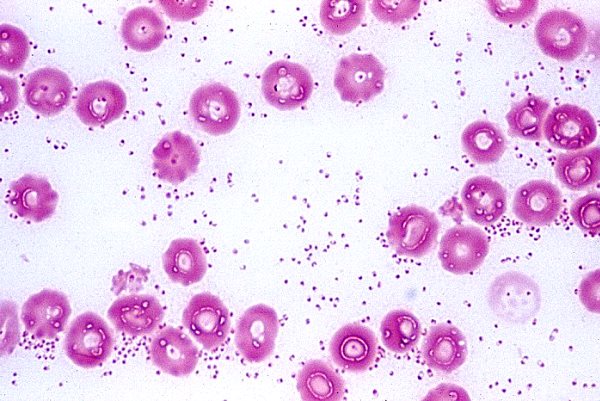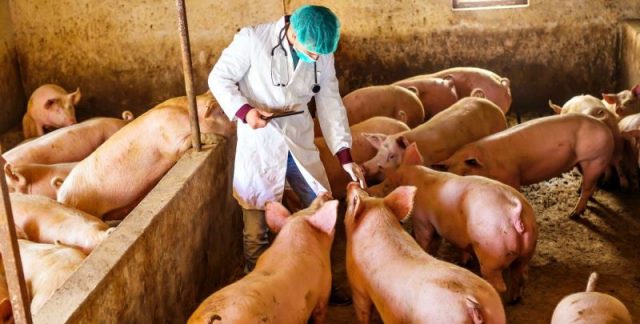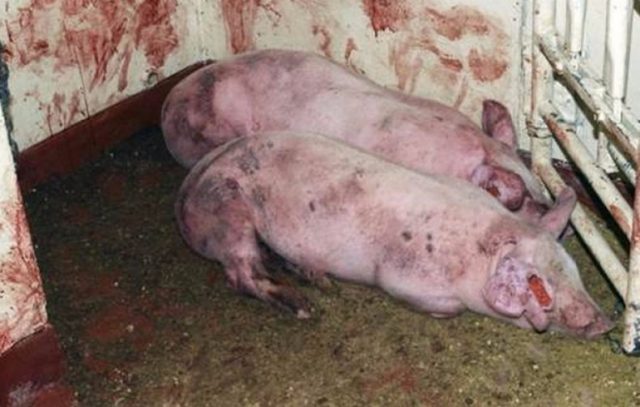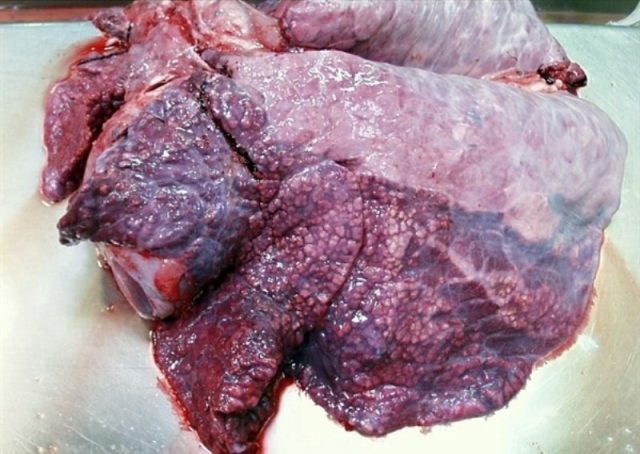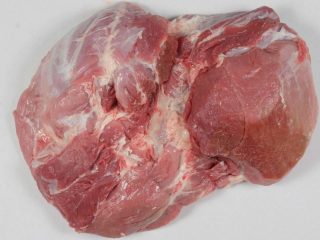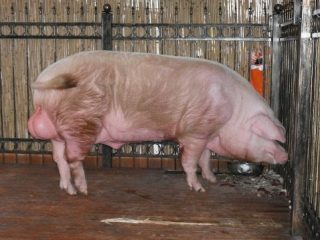Content
Pig Pasteurellosis is one of those diseases that can put an end to all calculations of a farmer to make a profit from pig breeding. The most susceptible to this infection are piglets, which are usually raised for the sake of sale. Adult pigs also get sick, but less often and tolerate the disease more easily than piglets.
What is this disease "pasteurellosis"
This bacterial disease is considered common in many animal species, including humans. The latter is usually infected with Pasteurella from pets. The causative agent of the disease in pigs is immobile bacteria Pasteurella multocida types A and D and Pasteurella haemolytica. The signs of pasteurellosis vary widely depending on the species of animal from which the bacteria were cultured.
Pasteurella has 4 serogroups classified: A, B, D, E. All these groups are similar in appearance and antigenic properties. Pasteurella looks like motionless oval rods 1.5-0.25 microns long. Refers to gram-negative bacteria. Do not form a dispute. All Pasteurella varieties grow on the same nutrient media, preferring the presence of blood in the broth.
Pasteurella is not highly resistant:
- when dried, they die after a week;
- in manure, cold water and blood can live up to 3 weeks;
- in corpses - 4 months;
- in frozen meat they remain viable for up to a year;
- when heated to 80 ° C, they die in 10 minutes.
The bacteria are not resistant to disinfectants.
What is the danger of the disease
Pasteurellosis usually develops along the path of an epizootic. Soon after infection of one individual, all pigs on the farm become ill. Most often, piglets observe an acute and hyperacute course of pasteurellosis. In adult pigs, a chronic course is found. Due to the peculiarities of the course of chronic pasteurellosis, the animal is more often treated for other diseases, contributing to the spread of pasteurella.
Causes and ways of infection
The bacteria are excreted together with the physiological fluids of the sick animal. Bacillary carriers can be outwardly healthy, but recovered pigs. Infection occurs through direct contact of animals by airborne droplets. Also, a healthy pig can get pasteurellosis through water and feed contaminated with feces or saliva. Carriers of pasteurellosis can be blood-sucking insects.
The preservation of bacteria in the external environment is facilitated by:
- untimely cleaning of machines, which contributes to an increase in humidity as a result of the evaporation of urine;
- poor quality feed that reduces the immunity of pigs;
- high overcrowding of animals, due to which pigs experience stress, which also leads to suppression of the immune system;
- lack of vitamins in the diet.
There were also outbreaks of pasteurellosis after vaccination against plague and erysipelas.
Symptoms of the disease in different forms
Pasteurellosis is a "variable" disease. Its signs change not only depending on the type of the course of the disease. In total, there are 4 types of the course of the disease:
- super-sharp;
- spicy;
- subacute;
- chronic.
They differ in the length of time that passes from the moment the first symptoms appear to the death of the pig.How pasteurellosis will proceed in each particular pig depends on the virulence of the bacteria and the resistance of the animal's immune system to the causative agent of the disease.
Hyperacute form
With the hyperacute form of pasteurellosis, the death of pigs occurs after a few hours. Signs of a hyperacute form:
- temperature 41-42 ° C;
- thirst;
- refusal of feed;
- depressed state;
- disturbances in the work of the cardiovascular and respiratory systems;
- possible diarrhea mixed with blood and mucus.
The disease progresses very quickly. Before the death of the pig, symptoms of heart failure, swelling of the head are observed. In pathological studies, pulmonary edema is detected.
Acute form
Symptoms of the acute form are the same as for hyperacute. Before death and during research, the same signs are found. Unlike hyperacute, with this course of pasteurellosis, death occurs after a few days.
Subacute form
Subacute and chronic course of pasteurellosis are also similar. In both cases, the disease is characterized by fever and localization of the process in individual systems of the pig's body. Depending on the localization of bacteria, pasteurellosis is divided into 3 forms:
Intestinal:
- debilitating diarrhea with dark brown or reddish feces;
- admixture of blood in manure;
- thirst;
- refusal of feed;
- exhaustion;
Pectoral:
- serous, later mucopurulent nasal discharge;
- possible blood in the nasal discharge;
- labored breathing;
- cough;
Edematous:
- inflamed swelling of the eyelids;
- swelling of the tongue and larynx;
- swelling of the subcutaneous tissue in the neck, abdomen and legs;
- difficulty swallowing;
- hard breath;
- discharge of thick saliva;
- heart failure.
Because of such a wide variability in the symptoms of pasteurellosis, this disease can be easily confused with other infections.
Chronic form
Symptoms and localization of bacteria in chronic course are similar to subacute. But since death occurs after a few weeks, more pathological changes have time to accumulate:
- depletion of corpses;
- fibrinous-hemorrhagic inflammation of the intestine;
- fibrinous-purulent inflammation with necrosis in the lungs.
Since in the subacute and chronic course of pasteurellosis, symptoms in pigs depend on the localization of bacteria, then treatment is prescribed only after its differentiation from plague, erysipelas and salmonellosis.
How is the disease diagnosed?
If pasteurellosis is suspected, parts of the corpses of dead pigs are handed over to the laboratory for research. The entire carcass is not needed in the laboratory, as pasteurellosis affects the internal organs. At autopsy, lesions are found:
- Gastrointestinal tract;
- lungs;
- heart muscle;
- spleen;
- liver.
The photo shows a lung of a pig killed by pasteurellosis.
In addition to the lungs and spleen, you can also send for research to the laboratory:
- brain;
- glands;
- lymph nodes;
- tubular bones.
Upon receipt of the biomaterial in the laboratory, the isolation of pasteurella and a bioassay on mice are also carried out.
Small pieces of organs 5x5 cm in size are handed over for analysis. Only material from those animals that did not have time to receive antibiotics during their lifetime is suitable for research.
Treatment of pasteuriliosis in pigs
Sick pigs are separated and placed in a warm, dry room. Provide complete feeding with high-quality feed. Treatment is carried out in a comprehensive manner, using antibacterial drugs and remedies for symptomatic treatment. Of the antibiotics, those belonging to the penicillin and tetracycline groups are preferred. The antibiotic is used according to the instructions for the drug. Some long-acting medications can be used once, but this should be indicated in the instructions. Sulfanilamide drugs are also used.
To enhance immunity, serum against pig pasteurellosis is used. It is administered once intramuscularly or intravenously at a dose of 40 ml per animal.
On sale you can find whey of Belarusian and Armavir production. From the instructions it follows that the difference between these two drugs is in the timing of the formation of passive immunity and the timing of protection against pasteurellosis.
After using the serum of Armavir production, immunity is formed within 12-24 hours and lasts for 2 weeks. In Belarusian, immunity is formed immediately after application, but it lasts only 1 week.
If there are sick animals on the farm, serum from pig pasteurellosis is also used as a prophylactic agent for animals that look healthy. Clinically healthy piglets under a sick sow are injected with serum in a therapeutic dose.
If pasteurellosis is detected on the farm, the farm is quarantined. The import and export of pigs outside the farm is prohibited. The carcasses of forcedly slaughtered pigs are sent for processing to a meat processing plant.
Prophylaxis
Prevention of pasteurellosis is, first of all, compliance with veterinary rules. Newly acquired pigs are quarantined for 30 days. The livestock is completed from farms free from pasteurellosis. Contact between pigs from different holdings is not allowed.
Pigs do not graze on waterlogged pastures, where pasteurellosis pathogens can persist for six months. They carry out regular deratization of the premises. Storage of feed is carried out in sealed containers inaccessible to rodents.
In areas unfavorable for pasteurellosis, the obligatory vaccination of pigs is carried out twice a year. On holdings where pasteurellosis has been reported, new pigs must either be vaccinated at the supplier during the year or vaccinated during quarantine. The introduction of unvaccinated animals into the herd is allowed no earlier than one year after the farm is rehabilitated.
Vaccine against pasteurellosis
Serum is made from the blood of recovered or vaccinated animals. It contains antibodies to pasteurellosis and acts immediately after administration.
Vaccine - a preparation containing pasteurella bacteria, neutralized by formalin. The vaccine should not be used on a farm where pasteurellosis has already been detected. In this case, vaccination can provoke the development of the disease.
In a farm located in a disadvantaged area or having previously experienced an outbreak of pasteurellosis, vaccination of pigs is mandatory. Only clinically healthy animals are vaccinated.
Vaccination is carried out twice. The formation of immunity occurs 20-25 days after the last vaccination. Immunity is maintained for 6 months.
Vaccinated sows impart immunity to piglets. The action of such "milk" immunity lasts 1 month, therefore, from 20-25 days of life, piglets are vaccinated twice with an interval of 20-40 days. Injections are given intramuscularly into the neck. The dose for a piglet is 0.5 ml.
Pregnant uterus receive a single double dose (1 ml) vaccination 1-1.5 months before farrowing. The vaccine is injected intramuscularly into the upper third of the neck.
Conclusion
Pasteurellosis of pigs is a disease that can be avoided if the conditions for keeping animals and their feeding rations are observed. Timely vaccination will significantly reduce the likelihood of contracting pasteurellosis, since the causative agents of this infection are the same in all animals. A pig cannot be relied upon to get infected from a chicken or rabbit.
